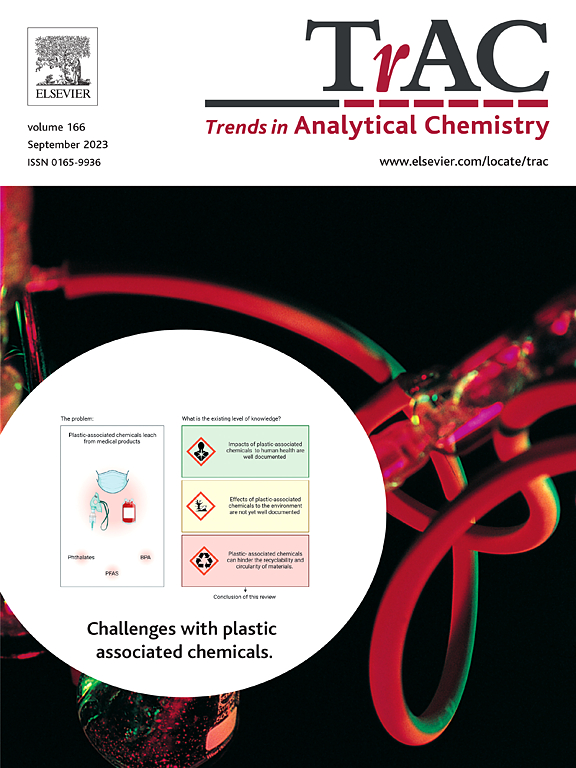NMR 在肝素和低分子量肝素中的应用
IF 12
1区 化学
Q1 CHEMISTRY, ANALYTICAL
引用次数: 0
摘要
核磁共振(NMR)是制药领域进行定性和定量分析的强大工具。动物肝素和低分子量肝素(LMWHs)是广泛用作抗凝剂的多糖混合物。在本综述中,主要对近年来有关 NMR 在肝素和 LMWHs 中应用的研究进行了分组和讨论。第一部分概述了 NMR 在肝素和 LMWHs 鉴定中的应用。我们的团队参与起草了三部 LMWHs 专著(依诺肝素、纳度肝素和达肝素),其中包括 NMR 作为鉴定方法,这可能会促进 2025 年版《中国药典》的修订。第二部分介绍核磁共振对肝素和 LMWHs 的定量分析。第三部分介绍了核磁共振与多元分析相结合在肝素不同动物来源鉴别、不同厂家肝素鉴别和肝素平均分子量测定中的应用。第四部分是通过核磁共振测定肝素与蛋白质复合物的结合界面。在 COVID-19 全球流行的情况下,临床上正确使用肝素和 LMWHs 有助于减少 COVID-19 的传播和死亡率。第五部分介绍了 NMR 在研究肝素在 COVID-19 预防和治疗中的作用方面的应用。第六部分报告了 NMR 在肝素相关药物开发中的一些应用实例。我们的综述表明,核磁共振是一种多功能工具,不仅能对肝素和 LMWHs 进行整体质量控制,还是一种很有前途的工具,能提供许多有价值的潜在用途信息。建议在肝素和 LMWHs 的开发、生产和质量控制过程中采用所讨论的方法。本文章由计算机程序翻译,如有差异,请以英文原文为准。
Applications of NMR in heparin and low molecular weight heparins
Nuclear magnetic resonance (NMR) is a powerful tool for qualitative and quantitative analysis in the pharmaceutical field. Animal-derived heparin and low molecular weight heparins (LMWHs) are mixtures of polysaccharides widely used as anticoagulants. In this review, studies mainly regarding the application of NMR in heparin and LMWHs in recent years are grouped and discussed. The first part presents an overview of the NMR applications in identification of heparin and LMWHs. Our team participated in the drafting of three LMWHs monographs (enoxaparin, nadroparin and dalteparin), including NMR as identification method, which may promote the revision of the 2025 edition of the Chinese Pharmacopeia. The second part presents the quantification of heparin and LMWHs by NMR. The third part describes the application of NMR combination with multivariate analysis in the distinguishment of different animal origins of heparin, the distinguishment of heparin from different manufacturers, and the determination of the average molecular weight of heparin. The fourth part deals with the determination of the binding interface of the heparin-protein complex by NMR. With the global epidemic COVID-19, proper clinical use of heparin and LMWHs have contributed to reducing the spread and mortality of COVID-19. The fifth part presents the NMR application in the study of the role of heparin in the prevention and treatment of COVID-19. The sixth part reports some examples of NMR applications in heparin-related drug development. Our review has shown that NMR is a versatile tool that not only provides holistic quality control of heparin and LMWHs but is also a promising tool that provides numerous valuable information for potential use. The discussed approaches are recommended to be implemented during the development, production, and quality control process of heparin and LMWHs.
求助全文
通过发布文献求助,成功后即可免费获取论文全文。
去求助
来源期刊

Trends in Analytical Chemistry
化学-分析化学
CiteScore
20.00
自引率
4.60%
发文量
257
审稿时长
3.4 months
期刊介绍:
TrAC publishes succinct and critical overviews of recent advancements in analytical chemistry, designed to assist analytical chemists and other users of analytical techniques. These reviews offer excellent, up-to-date, and timely coverage of various topics within analytical chemistry. Encompassing areas such as analytical instrumentation, biomedical analysis, biomolecular analysis, biosensors, chemical analysis, chemometrics, clinical chemistry, drug discovery, environmental analysis and monitoring, food analysis, forensic science, laboratory automation, materials science, metabolomics, pesticide-residue analysis, pharmaceutical analysis, proteomics, surface science, and water analysis and monitoring, these critical reviews provide comprehensive insights for practitioners in the field.
 求助内容:
求助内容: 应助结果提醒方式:
应助结果提醒方式:


